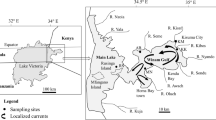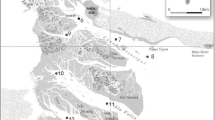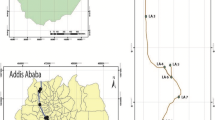Abstract
Spatial and seasonal contaminations of zinc, copper, cadmium, and lead were assessed simultaneously in water, sediment, and in the bivalve Arca senilis from the Milliardaires Bay (Cote d’Ivoire) between February and October 2008. The metal load in sediments doubled from the dry season to the rainy season. On the contrary, metal concentrations in waters decreased significantly from the dry season to the rainy season. Zn and Pb concentrations in A. senilis showed similar seasonal variation with sediments. On the other hand, A. senilis regulated Cu concentrations by eliminating about twelve times the concentration accumulated during the dry season. Apparent Zn, Cu, Cd, and Pb concentration gradients were observed, but no significant differences between stations for sediment, water, and A. senilis. Concentrations in sediment increased from stations close to Abidjan Harbor towards farther stations, while concentrations in A. senilis showed a reverse gradient. The distribution gradient of A. senilis indicates pollution from local sources, but a transplant experiment is needed to better understand the observed spatial trend. Zn and Cu concentrations may pose little risk to human health and the environment, but they are the highest on the regional scale. On the contrary, Cd and Pb concentrations in A. senilis exceeded the maximum allowable limits set by the European Commission. Complementary studies including chemical speciation should be considered to provide a more accurate assessment of the risk of heavy metals to the environment.




Similar content being viewed by others
References
Banerjee, K., Senthilkumar, B., Purvaja, R., & Ramesh, R. (2012). Sedimentation and trace metal distribution in selected locations of Sundarbans mangroves and Hooghly estuary, northeast coast of India. Environmental Geochemistry and Health, 34, 2–42.
Bastami, K. D., Bagheri, H., Haghparast, S., Soltani, F., Hamzehpoor, A., & Bastami, M. D. (2012). Geochemical and geo-statistical assessment of selected heavy metals in the surface sediments of the Gorgan Bay Iran. Marine Pollution Bulletin, 64, 2877–2884.
Bentum, J. K., Anang, M., Boadu, K. O., Koranteng-Addo, E. J., & Owusu Antwi, E. (2011). Assessment of heavy metals pollution of sediments from Fosou Lagoon in Ghana. Bulletin of the Chemical Society of Ethiopia, 25, 19–196.
Bodin, N., N’Gom-Ka, R., Ka, S., Thiaw, O. T., Tito de Morais, L., et al. (2013). Assessment of trace metal contamination in mangrove ecosystems from Senegal, West Africa. Chemosphere, 90, 150–157.
Buruaem, L. M., Hortellani, M. A., Sarkis, J. E., Costa-Lotufo, L. V., & Abessa, D. M. (2012). Contamination of port zone sediments by metals from large marine ecosystems of Brazil. Marine Pollution Bulletin, 64, 479–488.
Chakraborty, P., Babu, P. V. R., & Sarma, V. V. (2012). A study of lead and cadmium speciation in some estuarine and coastal sediments. Chemical Geology, 294–295, 217–225.
Chakraborty, P., Brij, M. S., Raghunadh Babu, P. V., Koffi, M. Y., & Saranya, J. (2014). Impact of total organic carbon (in sediments) and dissolved organic carbon (in overlying water column) on Hg sequestration by coastal sediments from the central east coast of India. Marine Pollution Bulletin, 79, 342–347.
Chen, C. Y., Borsuk, M. E., Bugge, D. M., Hollweg, T., Balcom, P. H., et al. (2014). Benthic and pelagic pathways of methylmercury bioaccumulation in estuarine food webs of the northeast United States. PLoS ONE, 9(2), e89305. doi:10.1371/journal.pone.0089305.
Coulibaly, S., Atse, B. C., Soumaılla, S., Kouadio, J. K., & N’Guessan, J. K. (2012). Seasonal accumulations of some heavy metal in water, sediment and tissues of black-chinned Tilapia Sarotherodon melanotheron from Bietri Bay in Ebrie Lagoon, Ivory Coast. Bulletin of Environmental Contamination and Toxicology, 88, 571–576.
Gandi, K., Han, S., Rezaie-Boroon, M. H., Porrachia, M., & Deheyn, D. D. (2011). Increased bioavailability of mercury in the lagoons of Lome, Togo: the possible role of dredging. Ambio, 40, 26–42.
Inza, B., & Yao, K. M. (2015). Physical and chemical parameters and trace metal concentrations in the Ebrie Lagoon (Côte d’Ivoire): influence of tides and urban waste waters. Journal of Materials and Environmental Science, 6, 1321–1329.
Joiris, C. R., & Azokwu, M. I. (1999). Heavy metals in the bivalve Anadara (Senilia) senilis from Nigeria. Marine Pollution Bulletin, 40, 457–460.
Joiris, C. R., Azokwu, M. I., Otchere, F. A., & Ali, I. B. (1998). Mercury in the bivalve Anadara (Senilia) senilis from Ghana and Nigeria. Science of the Total Environment, 224, 18–188.
Kouassi, N. L. B., Yao, K. M., Trokourey, A., & Soro, M. B. (2015). Distribution, sources, and possible adverse biological effects of trace metals in surface sediments of a tropical estuary. Environmental Forensics, 16(1), 96–108. doi:10.1080/15275922.2014.991433.
Li, X., Liu, L., Wang, Y., Luo, G., Chen, X., et al. (2012). Integrated assessment of heavy metal contamination in sediments from a coastal industrial basin, NE China. PLoS ONE, 7(6), e39690. doi:10.1371/journal.pone.0039690.
Lim, W. Y., Ahmad, Z. A., & Tengku, H. T. I. (2013). Spatial geochemical distribution and sources of heavy metals in the sediment of Langat River, western Peninsular Malaysia. Environmental Forensics, 14, 133–145.
Long, E. R., Bin, C., Smith, S. L., & Calder, F. D. (1995). Incidence of adverse biological effects within ranges of chemical concentrations in marine and estuarine sediments. Environmental Management, 19, 8–97.
Loring, D. H., & Rantala, R. T. T. (1990). Sediments and suspended particulate matter: total and partial methods of digestion. Techniques in Marine Environmental Sciences, 9, 1–14.
Official Journal of the European Union (EU) (2006). Commission regulation (EC) No 1881/2006 of 19 December 2006 setting maximum levels for certain contaminants in foodstuffs. OJ L 364, 5-24. Available at http://eur-lex.europa.eu/legal-content/EN/TXT/PDF/?uri=CELEX:32006R1881&from=en. Accessed 12 October 2014.
Okoye, B. C. O. (1991a). Heavy metals in the Lagos Lagoon sediments. International Journal of Environmental Studies, 37, 35–41.
Okoye, B. C. O. (1991b). Heavy metals and organisms in the Lagos Lagoon. International Journal of Environmental Studies, 37, 285–292.
Otchere, F. A. (2003). Heavy metals concentrations and burden in the bivalves (Anadara (senilia) senilis, Crassostrea tulipa and Perna perna) from lagoons in Ghana: model to describe mechanism of accumulation/excretion. African Journal of Biotechnology, 2, 280–287.
Pan, K., & Wang, W. X. (2012). Trace metal contamination in estuarine and coastal environments in China. Science of the Total Environment, 421–422, 3–16.
Pattelli, G., Rimondi, V., Benvenuti, M., Chiarantini, L., Colica, A., et al. (2014). Effects of the November 2012 flood event on the mobilization of Hg from the Mount Amiata mining district to the sediments of the Paglia River basin. Minerals, 4, 241–256.
Qiao, Y., Pan, H., Yang, Y., Gu, J., & Zhao, J. (2013). Distribution and accumulation of heavy metals in surface sediments from a subtropical bay affected by the Special Economic Zone, China. Water Science and Technology, 67, 2009–2016.
Tay, C. K., Asmah, R., & Biney, C. A. (2009). Trace metal levels in water and sediment from the Sakumo II and Muni Lagoons, Ghana. West Africa Journal of Applied Ecology, 16, 75–94.
USEPA (2001). Methods for collection, storage and manipulation of sediments for chemical and toxicological analyses: technical manual. EPA office of water. EPA- 823-B-01-002. Available at http://www.epa.gov/waterscience/cs/collection.html.
Vink, J. P. M. (2005). Heavy metal uptake rates among sediment dwelling organisms. Where do sediment-dwellers get their metals? In Water Encyclopedia, ISBN 0-47-44164-3. New York: John Wiley.
Wedepohl, K. H. (1995). The composition of the continental crust. Geochimica et Cosmochimica Acta, 59, 1217–1232.
Yao, K. M., Métongo, B. S., Trokourey, A., & Bokra, Y. (2009). Assessment of sediments contamination by heavy metals in a tropical lagoon urban area (Ebrié Lagoon, Côte d’Ivoire). European Journal of Scientific Research, 34(2), 280–289.
Zabi, S. G. F. & Le Loeuff, P. (1992). Revue des connaissances sur la faune benthique des milieux margino-littoraux d’Afrique de l’Ouest. Première partie: biologie et écologie des espèces. Revue d’Hydrobiologie Tropicale, 25, 209–251.
Zidoumou, Z., Gnassia-Barelli, M., Siau, Y., Morton, V., & Romeo, M. (2006). Heavy metal concentrations in molluscs from the Senegal Coast. Environment International, 32, 384–387.
Zuykov, M., Pelletier, E., & Harper, D. A. (2013). Bivalve mollusks in metal pollution studies: from bioaccumulation to biomonitoring. Chemosphere, 93, 20–208.
Acknowledgments
The help of Dr. Carl H. Lamborg for the improvement of this manuscript was greatly appreciated. Authors thank Mary Zawoysky and Adiari I. Vazquez-Rodriguez for improving the edits. This work is part of the Ministère de l’Enseignement Supérieur et de la Recherche Scientifique (Cote d’Ivoire) supported Institutional Project (Plan quinquennal). This article bears CRO contribution “BGF, chapter 600”.
Author information
Authors and Affiliations
Corresponding author
Rights and permissions
About this article
Cite this article
Bakary, I., Yao, K.M., Etchian, O.A. et al. Zinc, copper, cadmium, and lead concentrations in water, sediment, and Anadara senilis in a tropical estuary. Environ Monit Assess 187, 762 (2015). https://doi.org/10.1007/s10661-015-4976-6
Received:
Accepted:
Published:
DOI: https://doi.org/10.1007/s10661-015-4976-6




